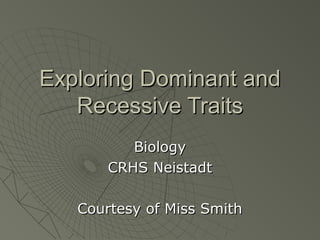
Exploring dominant and recessive traits
- 1. Exploring Dominant and Recessive Traits Biology CRHS Neistadt Courtesy of Miss Smith
- 2. Questions to Think About Let’s list together any genetic traits you can think of on the whiteboard. • For example: eye color, hair color Where do traits come from? What do you think Dominant or Recessive Traits are?
- 3. Where do traits come from? Your parents pass them down through genetic traits. You receive half of your genes from each parent Each person has about 70,000 pairs of genes. Genes can be dominant or recessive
- 4. Dominant Traits vs. Recessive Traits Dominant trait-Strongest trait Dominant trait-Masks or covers up the weaker trait • Which hair color do you think is dominant? • Which eye color do you think is dominant? • Which hair color do you think is recessive?
- 5. Formal Definition Dominant Trait: the trait observed n the first generation when parents that have different traits are bred. Recessive Trait: a trait that reappears in the second generation after disappearing in the first generation when parents with different traits are bred.
- 6. Common Misconception Recessive Traits are not rare traits. Dominant or recessive traits may be more common in a population. Example: Blonde hair is very common in parts of Scandinavia. Example: The trait of having six fingers on one hand is a dominant trait!
- 7. Partner Time! Get with a partner. Complete the worksheet together having your partner help you identify if you have the traits listed. Put a check mark beside the trait you have. We will share our results together at the end! When you have completed the worksheet, glue this page into your notebook. It should go onto page 13.
- 8. Earlobe
- 9. Dimples
- 10. Tongue Roller
- 11. Freckles
- 12. Eyelashes
- 13. Hair Line
- 14. Hair Type
- 15. Hair Color
- 16. Eyes
- 17. Lips
- 18. Thumb
- 19. Skin Pigment
- 20. Vision
- 21. Tongue to Nose
- 22. Fingers Do you have hair on your knuckles?
- 23. Interlaced Fingers Without thinking about it, interlace your fingers like the picture shows. If your left thumb is over your right, then you have the dominant trait.
- 24. Pinkie
- 25. Questions to think about Were traits that are dominant, actually dominant among our classmates? Is it possible to have traits that are not visible in your parents?
- 26. If time permits: Glencoe Biology Text chapter 10 Worksheet #49 & #17 from Pacemaker Text: Chapter 5
